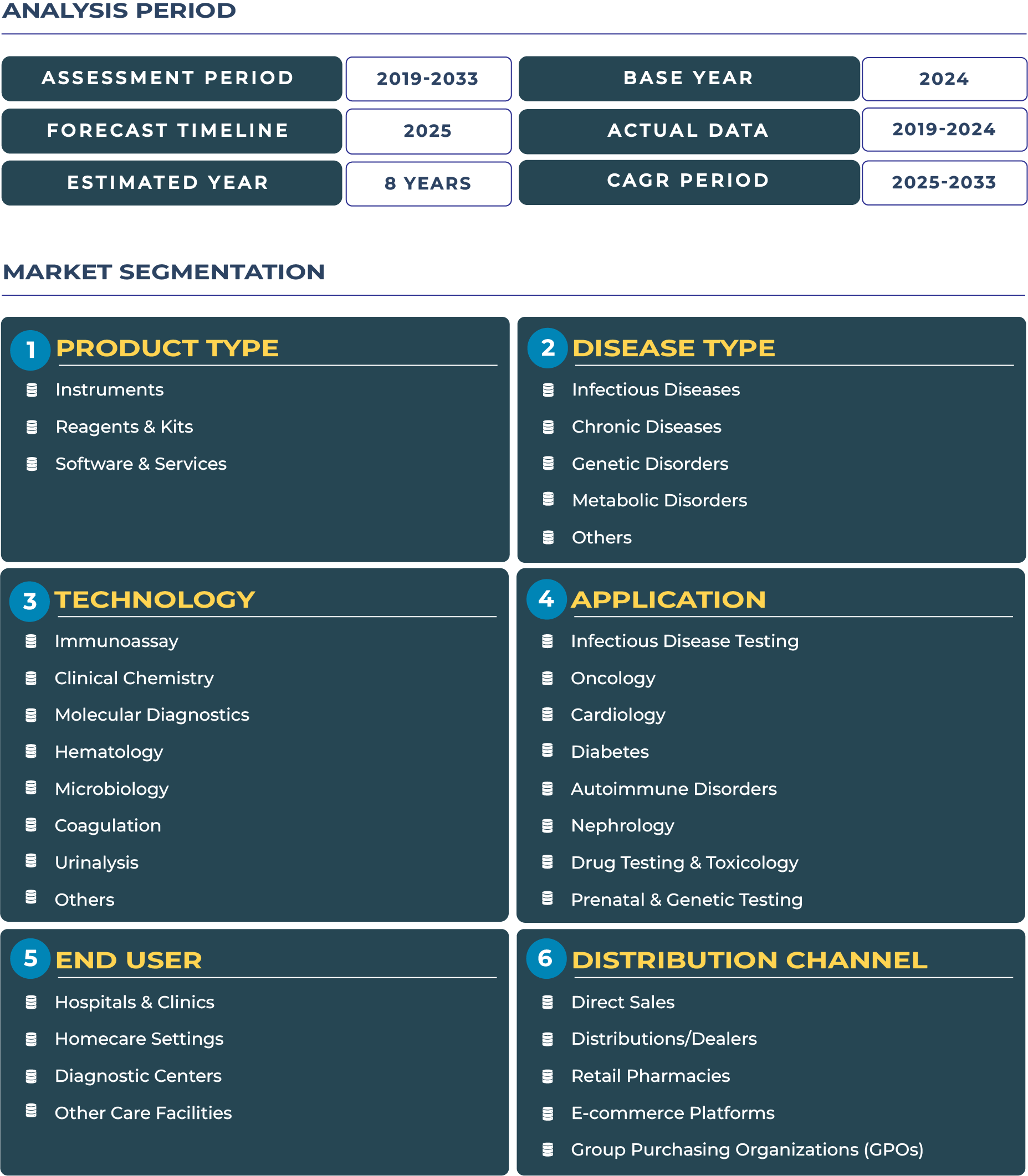Vietnam’s Rapid Healthcare Transformation Fuels a Booming In-Vitro Diagnostic Market
Vietnam’s healthcare infrastructure has undergone a remarkable transformation in recent years, marked by the expansion of private hospitals, increased government healthcare spending, and a growing middle-class demand for quality care. These developments have positioned the Vietnam In-vitro Diagnostic (IVD) Market as one of the fastest-growing healthcare segments in Southeast Asia. The market, valued at USD 629.2 million in 2025, is expected to reach USD 2,548.4 million by 2033, growing at a compelling CAGR of 19.1% during the forecast period. The combination of young demographics, rising chronic disease incidence, and digital health adoption has reinforced the nation’s focus on diagnostic innovation.
Vietnam IVD Market Outlook: Vietnam’s Healthcare Modernization Drives In-Vitro Diagnostic Expansion
Vietnam’s ambitious efforts to modernize its healthcare system have created a fertile environment for diagnostic innovation. The government’s initiatives under the Ministry of Health (MOH) have prioritized digital transformation, laboratory automation, and early disease detection, all of which are critical to the evolution of the in-vitro diagnostic industry. A surge in private hospital networks, such as Hoan My Medical and Vinmec, has increased demand for advanced IVD testing systems, including molecular diagnostics, hematology analyzers, and clinical chemistry reagents. Moreover, the expansion of urban healthcare facilities has improved access to quality testing, particularly in Ho Chi Minh City and Hanoi, where demand for preventive screening continues to rise.
Vietnam’s young yet aging population, with a growing prevalence of non-communicable diseases such as diabetes and cardiovascular disorders, is driving adoption of sophisticated diagnostic solutions. Additionally, the rise of localized reagent manufacturing and integration of AI-driven diagnostic platforms are transforming traditional laboratory workflows. The IVD market’s growth trajectory is expected to be further supported by foreign investment inflows encouraged by favorable policies and tax incentives designed to attract medical technology firms.
Market Drivers and Restraints: Balancing Growth Momentum with Systemic Challenges
Fast Private Hospital Roll-Outs and Expanding Diagnostic Reach
Vietnam’s rapid rollout of private healthcare infrastructure is a major catalyst behind its accelerating in-vitro diagnostic ecosystem. Private chains are increasingly collaborating with international diagnostic leaders to deploy advanced testing systems and automation technologies. For example, partnerships between domestic healthcare providers and global firms like Siemens Healthineers have enabled adoption of integrated laboratory platforms and software-driven quality assurance modules. Furthermore, urbanization and rising per-capita income have expanded access to routine diagnostics, driving volume growth in clinical laboratories and hospitals.
Regulatory and Reimbursement Barriers Impact Market Penetration
Despite positive momentum, Vietnam IVD market faces structural barriers such as complex product registration timelines, inconsistent reimbursement mechanisms, and limited access in provincial regions. Regulatory review delays under the national medical device approval system often extend market entry for new IVD technologies. In rural provinces, low laboratory density and shortage of trained technicians hinder widespread adoption. Furthermore, limited insurance coverage for diagnostic testing restricts affordability for low-income populations, impeding broader market expansion. While regulatory reforms are ongoing under Vietnam’s National Medical Device Management strategy, their implementation remains gradual.
Emerging Trends and Strategic Opportunities in Vietnam In-Vitro Diagnostic Sector
Private Chain Expansion and Local Distributor Empowerment
A notable trend shaping the Vietnam in-vitro diagnostic landscape is the expansion of private healthcare chains that prefer integrated diagnostic models. These facilities are investing heavily in real-time data integration, lab automation, and quality control solutions. Simultaneously, the emergence of local distributors with strong technical capabilities is enabling faster market entry for international diagnostic manufacturers. This trend supports not only product localization but also after-sales service networks, an essential factor for sustaining operational uptime in clinical laboratories.
Investment Inflows and Localization of Diagnostic Manufacturing
Vietnam’s favorable foreign direct investment policies have attracted multinational diagnostic manufacturers to establish regional supply and service centers. The growth of local reagent production and assembly plants contributes to price competitiveness and supply chain resilience. In parallel, opportunities are arising in workforce training and academic partnerships to strengthen laboratory capacity. Companies that invest in skill development and collaborate with local medical universities are positioned to secure long-term market leadership. Furthermore, the integration of data-driven diagnostics and software solutions enhances interoperability and clinical decision-making, core differentiators in the evolving IVD sector.
Competitive Landscape: Collaborative Strategies and Market Leadership in Vietnam IVD Ecosystem
The competitive landscape of the Vietnam in-vitro diagnostic market is defined by both global and regional players advancing through partnerships, product innovation, and localization strategies. Key market participants include Roche Diagnostics, Abbott Laboratories, Siemens Healthineers, and local companies such as VietLab and Medicon. In 2024, Roche strengthened its presence by collaborating with Vietnamese hospitals for the deployment of advanced molecular testing solutions for oncology and infectious diseases. Similarly, Abbott’s focus on expanding reagent and POCT (Point-of-Care Testing) portfolios has accelerated adoption in urban diagnostic centers.
Market players are increasingly pursuing strategies like local manufacturing alliances and capacity-building initiatives. Partnering with private hospital chains offers immediate testing volume and operational efficiency, while localized reagent production ensures competitive pricing. Investments in technician training and digital infrastructure are further enhancing accuracy and patient outcomes. This competitive synergy is transforming Vietnam into a regional hub for diagnostic innovation and cross-border healthcare collaboration.







